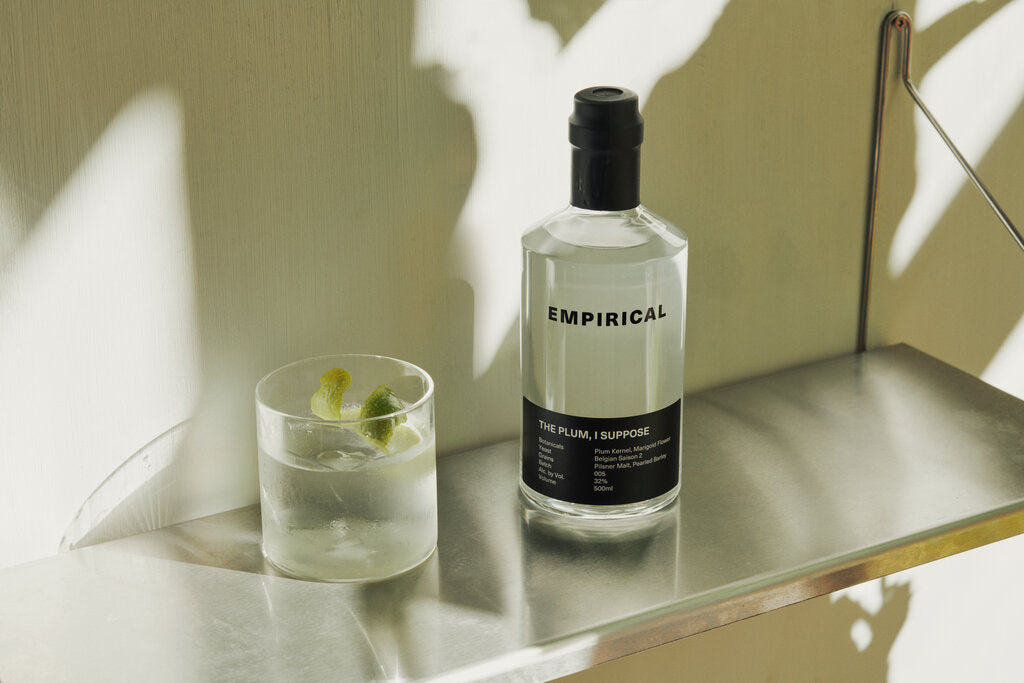The Plum, I Suppose is inspired by a dessert Lars once had; he still maintains that this is the best dessert of all time. It plays with the perception of sweetness without the often palate-numbing sugar.
The Plum, I Suppose relies on the balance between two very different components. The kernel inside the plum stones is the foundation of this spirit, lending a marzipan, bitter almond flavor. Distilled marigold kombucha contributes floral and tannic notes somehow reminiscent of plum skins.
As R&D was doing a deep dive into the idea of what we consider tea. If we were to step away from the traditional leaves and instead infuse a wide range of dry ingredients such as shaved wood, dried fruits, or fig leaves, could it be seen as tea? That’s how we got to marigold: it has tonic, floral notes that add both vibrance and aromatics to the final spirit.
The Plum, I Suppose is an instance where two very different ingredients combine to form a third completely different expression. The name is a reference to the Robert Frost poem, “The Rose Family.” One gets the sense of a delicate umeshu, a slight plum fruit flavor over an undercurrent of bottom notes that are ephemerally familiar. The top notes are what brought us to the name; there is no fruit in the spirit at all.

The Process
The Grains
Empirical is a flavor company. This means that every step of production has its role in bringing flavor to our spirits. Drawing from our culinary background, doing macerations in a bought-in neutral grain spirit did not make sense. That’s why we make everything from scratch, from grain to bottle.
The Plum, I Suppose story commences with kōji.
Kōji-kin (Aspergillus Oryzae) is a strain of spores, paramount to the production of many Asian drinks and culinary delights. You find it in sake, shōchū, miso, shōyu or mirin. Through enzymatic reactions, the mold converts starches and proteins into amino acids and fermentable sugars.

We grow our kōji on Danish organic pearled barley as opposed to the more traditional rice. Our barley is polished to 60% to remove the first layers of proteins and facilitate the growth of the spores. The grain is first steamed in the Dairy Queen, a converted 60-year-old butter churner from Jylland. When cooked, the pearled barley falls down into a sauna-like “kōji room” lined with naturally anti-microbial Douglas fir wood. It’s kept at 37 degrees Celsius and 70 percent humidity at all times. Kōji-kin spores are sprinkled on the cooked grains and left to ferment for two days until it turns into a dense white cake-like substance.
Our barley kōji imparts fragrant floral and fruity nuances as well as umami earthy flavors shining through The Plum, I Suppose.
Brewing
Mashing is the first step in the brewing process for our spirits and cans. In a custom-built wet hammer mill that’s on a loop with our mash tun, the grains are ground with water and heated to fully convert the starches into fermentable sugars. When done, the wort (sugary liquid) must be separated from the undissolved materials.
To make our wash for The Plum, I Suppose, we brew our barley kōji with water and keep it at a temperature of 50°c. The addition of enzymes from White Labs helps further break down the last unfermentable sugars into fermentable ones. We then add this koji brew to our filtered Pilsner malt wort and Belgian Saison yeast to ferment. This strain contributes estery, fruity notes, with a bit of farmyard aromas to our wash. Our wort is transferred into tanks where It is top-fermented at 26 Celsius. If we hit it just right, the wash reaches 10% abv after a week, ready to be distilled.

Distillation and maceration
Traditional distillation techniques rely on heat, which can kill off flavor. Instead, we vacuum distill our spirits in order to preserve the fresh flavor and aroma compounds of the botanicals.
Vacuum distillation works with a pump that pulls the atmosphere out of the distillation vessel, lowering the pressure so that ethanol begins to boil and evaporate as low as 9°C,
After distilling our wash twice at an average temperature of 30°C, we have what we call a “low wine”, which is around 60% ABV. We transfer it into stainless steel barrels and start our maceration process.
We first mill our plum stones to release the kernel inside and add it to our low wine under pressure for two days to best capture the marzipan nuances. We also macerate our dried marigold flowers separately for two days.
We are now ready to do our second round of distillation, starting at 10°C. Instead of taking the regular four cuts throughout the distillation process, we take on average 150 cuts that we then taste individually. It helps shatter the flavor of the botanicals into shards we can later blend, each bringing their own nuances.

Blending
Once the cuts of both distillates are selected, we end up with a blend at 65% ABV, above the optimum flavor expression.
While distillers traditionally solely rely on water to reduce the ABV, we opted for the addition of distilled kombucha in The Plum, I Suppose. We take once again our marigold petals and macerate them in our in-house neutral kombucha for two days before distilling. We vacuum distill our kombuchas the same way as our spirits and take as many cuts. This allows us to have far more control over the spectrum of flavors in the final recipe. We taste each cut and blend accordingly. Both the distilled kombucha and water are used to reduce to 32% ABV. Our distilled marigold flower kombucha provides a beautiful, slightly tannic structure over which to lay the delicate plum kernel distillate of the Plum, I Suppose.


